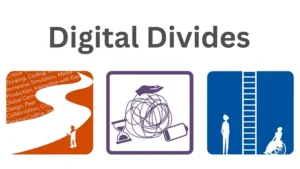
The National Educational Technology Plan (NETP) is the flagship educational technology policy document for the United States and articulates a vision of equity that calls upon all involved in American education to ensure every student has access to transformational learning experiences supported by technology. While educators and leaders at the school, district, and state level are critical for achieving this vision, the developers of educational technology, as well as funders of research & development, have an important part to play.
Every edtech tool reflects key decisions and assumptions that developers have made about the students, families, teachers, and leaders who will ultimately use their solution. As a starting point, every developer should reflect on those assumptions to determine if the tools they are developing are closing — or unintentionally widening — the three digital divides that are the focus of the NETP.
Critical questions relating to the three digital divides called out in the 2024 NETP include:
Digital Access (connectivity, devices, content, accessibility, digital health, safety, & citizenship):
- Would students be able to use your edtech tool without or with limited internet connectivity?
- Does your edtech tool comply with industry accessibility standards and requirements?
- Does your tool include guidance for students, teachers, and families that helps users understand possible digital health, safety, and citizenship concerns?
Digital Design (Universal Design for Learning; teacher time and capacity):
- Does support for your tool move beyond training on its features to include informed professional learning opportunities on maximizing its effectiveness as a part of a diverse ecosystem of digital resources?
- Is your tool designed to work seamlessly with other edtech tools and platforms that educators may use in their classrooms?
- Do documentation and front- and back-end user interfaces highlight alignment to the principles of the Universal Design for Learning (UDL) Framework?
Digital Use (active student creation and critical analysis):
- Does your edtech tool make assumptions about the technical proficiency of the teachers or students who will be using the tool in the classroom?
- Does your edtech tool include a research base verifying its prior effectiveness?
- Does your edtech tool include transparency features to help users access, analyze, and apply learner data?
- How does your edtech tool ask students to be active creators and participants in their own learning?
- How does the intended use of your edtech tool align to a UDL Framework?
The following are some immediate, high impact steps that edtech developers can take to ensure the tools they create are helping to bridge the three digital divides.
- Adopt and highlight alignment to accessibility standards & consider available industry certifications for validation.
- Adopt and highlight alignment to the UDL Framework & consider explicit alignment to industry certifications for validation.
- Highlight products’ multi-modal pathways to engaging with content, as well as demonstrating and assessing learning.
Edtech developers are encouraged to read the full report for more recommendations and examples of states, districts, and schools that are using technology effectively to drive outcomes for learners.